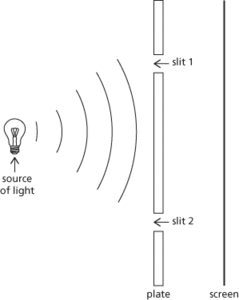An experiment that demonstrates the dual wave-particle nature of both light and electrons. In the earliest version of this experiment, reported by Thomas Young in 1801, light from some source impinges on a plate with two slits in it, with a screen being behind the plate. This results in an interference pattern, thus demonstrating the wave nature of light. In the 1920s similar experiments were conducted with electrons. These experiments also resulted in interference patterns, thus demonstrating the quantum-mechanical wave nature of electrons. Subsequent experiments demonstrated the wave nature of particles described by quantum mechanics, including protons, neutrons, and atoms.

Double-slit experiment.
When this type of experiment involves quantum-mechanical particles (such as electrons or photons of light) being fired from the source one at a time, it is found that each particle results in a single spot on the screen, thus demonstrating the particle nature of these entities; but an interference pattern builds up as more and more of these entities are fired.
Many elaborations of this experiment have been performed and analysed theoretically. It was said of the double-slit experiment by Richard Feynman that it ‘has in it the heart of quantum mechanics’.